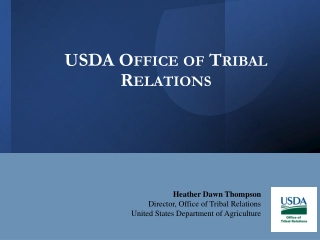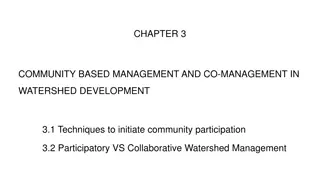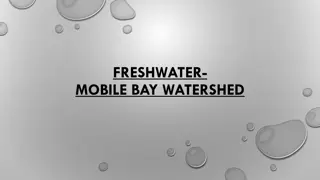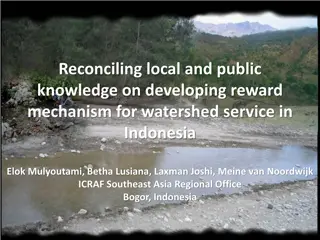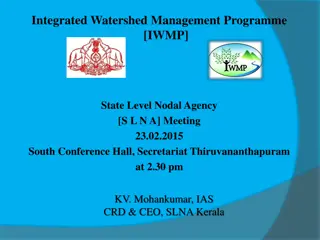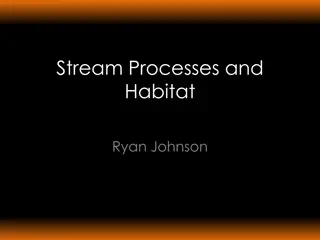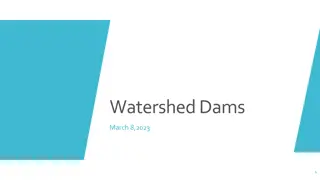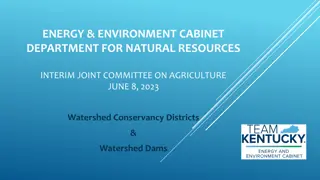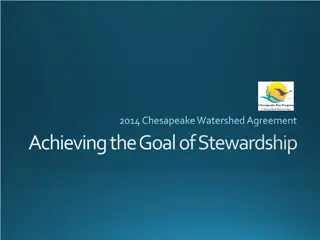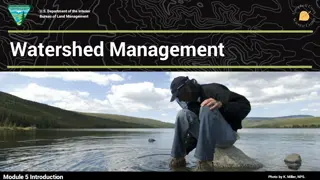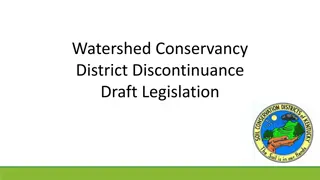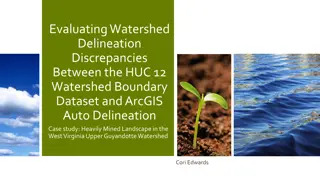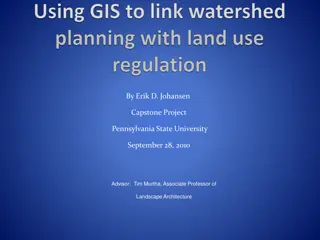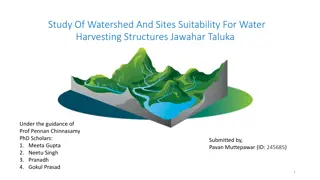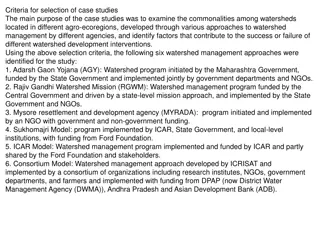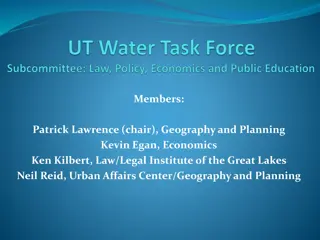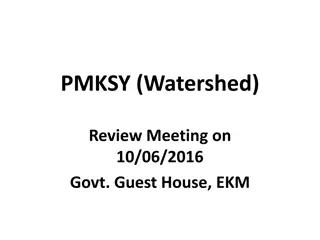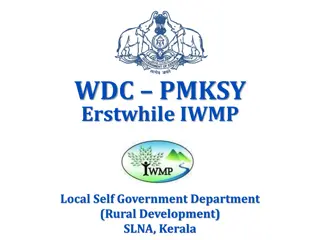Understanding USDA Watershed Programs for Local Communities
USDA Watershed Programs offer assistance in addressing natural resource issues such as flood control, repairing flood damages, and rehabilitating flood control dams. The three major components - Emergency Watershed Program (EWP), Watershed Protection and Flood Control Program (WPFO), and Watershed Rehabilitation Program (REHAB) - require a local government sponsor to request assistance from the USDA NRCS. The EWP provides federal emergency recovery aid to communities after natural disasters, offering technical and financial support for mitigating threats. The application process involves formal requests, damage survey reports, and implementation phases. These programs help communities recover and protect against natural disasters.
Download Presentation

Please find below an Image/Link to download the presentation.
The content on the website is provided AS IS for your information and personal use only. It may not be sold, licensed, or shared on other websites without obtaining consent from the author. Download presentation by click this link. If you encounter any issues during the download, it is possible that the publisher has removed the file from their server.
E N D
Presentation Transcript
USDA Watershed Programs Steps in Requesting Program Funding
THERE ARE THREE MAJOR COMPONENTS OF THE USDA WATERSHED PROGRAM AVAILABLE TO LOCAL COMMUNITIES. THESE CAN PROVIDE ASSISTANCE TO ADDRESS NATURAL RESOURCE ISSUES SUCH AS FLOOD CONTROL, REPAIRING DAMAGES FROM FLOODING AND RELATED NATURAL DISASTERS AS WELL AS REHABILITATION OF FLOOD CONTROL DAMS CONSTRUCTED WITH THE ASSISTANCE OF THE USDA WATERSHED PROGRAM.
Those components are: The Emergency Watershed Program (EWP) The Watershed Protection and Flood Control Program (WPFO) The Watershed Rehabilitation Program (REHAB)
These Programs all require a sponsor that makes a request for assistance from the USDA Natural Resources Conservation Service (NRCS), the agency that administers the programs Sponsors must be a unit of local government such as a conservation district, water improvement district, county, city, town or tribal government
The Emergency Watershed Protection Program (EWP), is a federal emergency recovery program, helps local communities recover after a natural disaster strikes The program offers technical and financial assistance to help local communities relieve imminent threats to life and property caused by floods, fires, windstorms and other natural disasters that impair a watershed Emergency Watershed Program Project: Retaining Walls Control Landslides in Sheridan Wyoming Project Protects School and Goose Creek
Emergency Watershed Program (EWP) Application Phase: Sponsor submits formal request to NRCS for assistance NRCS completes Damage Survey Reports (DSR) NRCS National Office sends funds to NRCS state office NRCS and sponsor enter into formal agreement Implementation Phase: Emergency Work is performed
The Watershed Protection and Flood Prevention Program helps units of federal, state, local and tribal of government (project sponsors) protect and restore watersheds up to 250,000 acres. This program provides for cooperation between the Federal government and the states and their political subdivisions to work together to prevent erosion; floodwater and sediment damage; to further the conservation development, use and disposal of water; and to further the conservation and proper use of land in authorized watersheds. There are 2,100 active or completed watershed projects in the 50 states, the Commonwealth of Puerto Rico and the Pacific Basin. Dams are included in 1,271 of those projects.
Application Phase: Sponsor submits formal request to NRCS for assistance NRCS submits funding request for a Preliminary Investigation and Feasibility Report (PIFR) Sponsors develop PIFR If feasible, sponsor submits form SF424 requesting federal funding
Planning Phase: NRCS State Conservationist requests planning authority Work plan is developed with community and sponsor NRCS Chief authorizes watershed plan Implementation Phase Funds are awarded as soon as they are available
The Watershed Rehabilitation Program helps project sponsors rehabilitate aging dams that are reaching the end of their design lives. This rehabilitation addresses critical public health and safety concerns. Only dams installed under PL-566, the Pilot Watershed Program, PL-534, or RC&D Programs are eligible. Mountain Creek Dam No. 10 in Ellis County, Texas after rehabilitation project. New roller compacted concrete spillway was installed as part of the project.
Application Phase: Sponsor submits formal request to NRCS for assistance NRCS performs dam assessment If dam needs rehabilitation sponsor may request planning assistance Sponsor submits request and documentation for planning assistance to NRCS NRCS state office reviews request and submits request for funding to the NRCS National Office
Planning Phase: Planning assistance is funded and planning begins Plan is completed and authorized for implementation (design and construction) Implementation Phase Design is funded and completed Construction is funded and completed
For additional information on these programs and learn more about how to request NRCS assistance contact your local NRCS field office or your NRCS state office Find your state NRCS office here: https://www.nrcs.usda.gov/wps/portal/nrc s/main/national/contact/states/
For Additional Information or Assistance nwchdqtrs@sbcglobal.net www.watershedcoalition.org https://www.facebook.com/National-Watershed- Coalition-1422764781292195/
National Watershed Coalition The NWC is a nonprofit 501(c)(3) Coalition made up of national, regional, state, and local organizations, associations, and individuals, that advocate dealing with natural resource problems and issues using watersheds as the planning and implementation unit.


